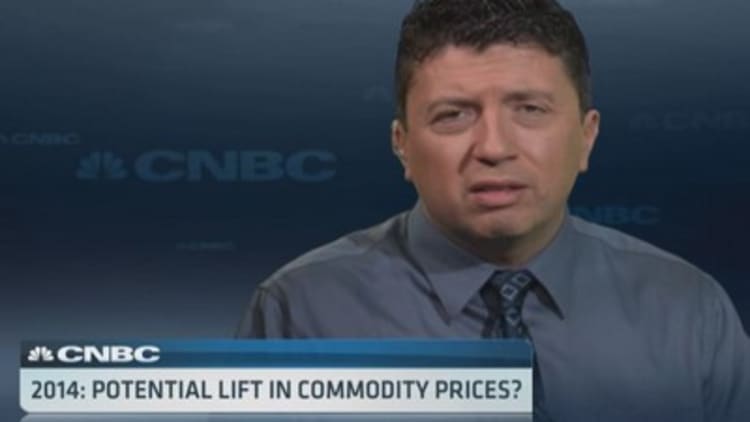
With the growing number of calls for a significant stock market pullback ahead, one area likely to start seeing investor inflows is commodities.
The space has suffered a rough couple of years as the so-called Commodity Supercycle broke down. Strong supplies of various crops, wobbly global economic growth and a meltdown in gold and other metals caused prices to sag and money to flow to equities.
But the damage may have been done, setting the stage for a rebound. Experts see opportunities in metals outside gold as well as selected agricultural commodities.
Commodity watchers believe the market is nearing a point where it has priced in the commodity downturn and is ready to swing the other way.
"There's an argument that commodities have gone massively out of favor," said Nick Brooks, head of research and investment strategy at ETF Securities. "I would argue they actually have been ignored as an asset class."
(Read more: There's a reason behind those surging solar stocks)
Brooks' bullish case for commodities rests in part on a belief that gold has been the reason for the preponderance of negative perceptions.
Exchange-traded products in 2013 surrendered about a quarter of their assets under management, taking that total down to $122 billion. Of those $78 billion in outflows, though, fully $25 billion came from the SPDR Gold Shares Trust ETF, while the iShares Gold Trust surrendered another $2.4 billion, while multiple other metals-related funds lost as well, according to IndexUniverse, .
"When you break down the numbers in some detail, 91 percent of the assets under management decline was due to gold," Brooks said. "For commodity ETFs excluding gold, outflows accounted for less than 1 percent of the overall decline."
If early 2014 trends hold up, that is likely to change.
Gold jumped out of the gate, posting strong gains in the first weeks of January. Elsewhere in precious metals, platinum posted strong gains as the stock market wobbled and bond yields backed off.
For the full year, Brooks expects an overall improving global growth story to be the driving force behind commodity price appreciation.
"To the degree that we continue to see continued healthy growth of out of the U.S. and China, there could be some supply disappointments considering the aggressive forecast in place," he said. "Commodities do tend to be a later-stage cyclical asset, so it's not abnormal for commodities to lag a rally in equities."
To be sure, there are headwinds.
(Read more: ETF investors pour billions overseas)
Oil prices, for instance, could sag as some semblance of order is restored in the Middle East.
And Federal Reserve policy may not be particularly friendly to the space as well as the central bank pulls back on its quantitative easing program. The reduction of the monthly purchases of Treasurys and mortgage-backed securities likely will boost the U.S. dollar, a move that historically can be rough on commodities.
But if the stock market continues its retreat and enters a 10 percent correction phase, as many Wall Street forecasters predict, investors will be looking for return, at least until they get brave enough to start buying the equity dip.
"If the S&P 500 starts giving a little, we'll start seeing some rolling into these assets," said Michael Gurka, managing director at Spectrum Asset Management in Chicago. "The correction is definitely here."
(Read more: Monsanto wins high court challenge on seed patents)
Over the longer term, Gurka believes industrial metals and grain will outperform.
While Brooks thinks gold probably is in a trading range that will keep it between $1,200 and $1,400, he sees plenty of opportunities in other metals such as platinum and palladium.
"I don't think (global growth) has been factored into commodity prices," he said. "Investors have been focused on the supply-side increases across commodities and have been less focused on the demand side. Therefore, if the U.S. economy continues to power ahead and China manages to maintain 7 to 8 percent growth in 2014, that has the potential to lift commodity prices."
—By CNBC's Jeff Cox. Follow him on Twitter @JeffCoxCNBCcom.




